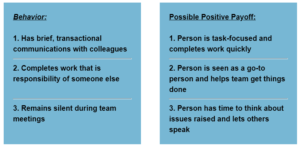Modifying habitual behaviors is no easy task. Even if you’ve identified the direct negative impacts that the behavior has on yourself and others, you may still feel hesitant to change. Part of the reason for the hesitation could be that the existing behavior provides a positive payoff of some kind. Here are some examples:

So, how do you balance the positive payoffs with the downsides? Run some experiments and see which behavior modifications work best. Here’s how to start:
- Identify 1-3 small things that you could try.
- Identify the situations and individuals with whom you will try your new actions.
- Record the impact of your new actions, both on yourself and on others. Notice what changed and what did not.
- What kind of positive payoff did you experience?
- How successfully did you mitigate the downsides for yourself? For others?
- Specify what additional behavior experiments you can run to balance the payoffs and downsides.
If you are helping an employee work through behavior change, suggest they complete the same steps. Ask them when they will start their experiments and set up a time to check back in together.
Not every experiment with new behaviors will be successful. If you get stuck on what to try next, ask a mentor, or someone who has successfully changed in a similar environment.
If you have questions or feel stuck in jumpstarting behavior change, feel free to reach out to lauren@evoluteconsult.com.



